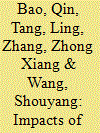|
|
|
Sort Order |
|
|
|
Items / Page
|
|
|
|
|
|
|
| Srl | Item |
| 1 |
ID:
150064


|
|
|
|
|
| Summary/Abstract |
This paper presents a theoretical model and addresses several issues related to life cycle cost analysis to illustrate how time-inconsistent preferences affect consumer choice. The particular case study selects involved consumer choice between a vehicle with high initial acquisition cost but low ownership cost (e.g., an Electric Vehicle, EV) and one with a low initial acquisition cost but high ownership cost (e.g., a conventional Internal Combustion Engine Vehicle, ICEV). To test our theoretical analysis, we conduct an empirical study on how time discounting rates affect consumer choice between ICEVs and EVs with different initial cost ratios. From the survey results, we find that individuals with higher present bias showed irrational purchase behavior even when controlling for wealth level. Specifically, people making some “stronger bias to present” decisions chose higher total cost ICEVs with lower initial cost but higher ownership cost over lower total cost EVs with higher initial cost and lower ownership cost. However, people’s long-term discount is not correlated with irrational vehicle purchase behavior. Furthermore, we study the present bias and long-term discount rate in one scenario and found present bias to be correlated with irrational behavior.
|
|
|
|
|
|
|
|
|
|
|
|
|
|
|
|
| 2 |
ID:
119207


|
|
|
|
|
| Publication |
2013.
|
| Summary/Abstract |
Carbon-based border tax adjustments (BTAs) have recently been proposed by some OECD (Organization for Economic Co-operation and Development) countries to level the carbon playing field and target major emerging economies. This paper applies a multi-sector dynamic, computable general equilibrium (CGE) model to estimate the impacts of the BTAs implemented by the US and EU on China's sectoral carbon emissions. The results indicate that BTAs will decrease export prices and transmit the effects to the whole economy, affecting sectoral output and demand from both the supply side and demand side. On the supply side, sectors might move away from exporting towards the domestic market, thereby increasing sectoral supply, while on the demand side, the domestic income may be strikingly cut down due to the decrease in export price, decreasing sectoral demand. Furthermore, such shrinkage of demand may similarly reduce energy prices, which would lead to an energy substitution effect and somewhat stimulate carbon emissions. Depending on the relative strength of the output-demand effect and energy substitution effect, sectoral carbon emissions and energy demands will vary across sectors, with increases, decreases or shifts in different directions. These results suggest that an incentive mechanism to encourage the widespread use of environment-friendly fuels and technologies will be more effective than BTAs.
|
|
|
|
|
|
|
|
|
|
|
|
|
|
|
|
| 3 |
ID:
111393


|
|
|
|
|
| Publication |
2012.
|
| Summary/Abstract |
To realize environmentally sustainable development of the economy, China has decided to cut carbon dioxide emissions per unit of GDP by 40 to 45 percent by 2020, compared with the level in 2005. Based on China's emission abatement target, this paper first analyzes enterprises' emission reduction pathways in practical production processes, and then develops a framework to derive the magnitude of investment required in each pathway in order to achieve the designated target at the minimal cost. Under the framework, it is found that in the absence of policy guidance, individual enterprises' emission reduction investments deviate from the optimal level. To correct the distortion, an alternative option is provided. Meanwhile, to ensure achievement of the emission reduction target, a stochastic model is introduced to measure the uncertainty arising from emission abatement investment. The results show that an appropriate emission abatement ratio can reduce 'the systemic risk' of emission abatement. Finally, a simulation is given to demonstrate the results derived from the stochastic model.
|
|
|
|
|
|
|
|
|
|
|
|
|
|
|
|
|
|
|
|
|